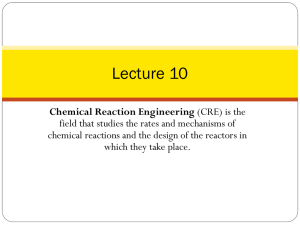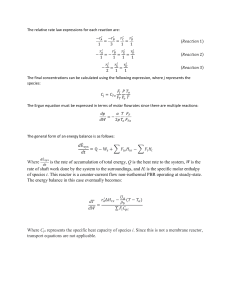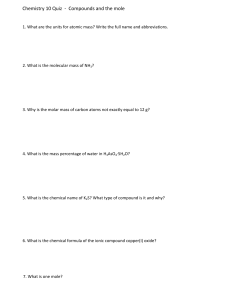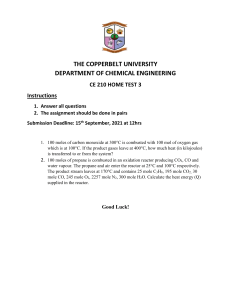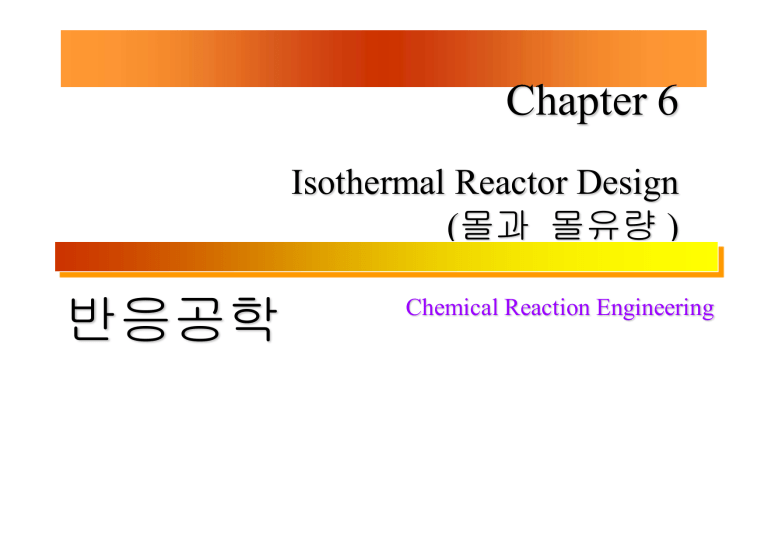
Chapter 6 Isothermal Reactor Design (몰과 몰유량 ) 반응공학 Chemical Reaction Engineering Using CA (liquid) and FA (gas) in the mole balance and rate laws •There are many instances when it is much more convenient to wor k in terms of the number of moles (NA, NB) or molar flow rates (FA, FB, etc) rather than conversion. •Membrane reactors and multiple reactions taking place in the g as phase are two such cases where molar flow rates are preferred rather than conversion. •We now modify our algorithm by using concentration for liquids an d molar flow rates for gases as our dependent variables. •The main difference between the conversion algorithm and the mo lar flow rate/concentration algorithm is that, in the conversion algorit hm, we needed to write a mole balance on only one species, where as in the molar flow rate and concentration algorithm, we must write a mole balance on each and every species. Unsteady-State Operation of Stirred Reactors • Startup of a CSTR : Determine the time to reach steady-state operation • Semibatch reactor : Predict the concentration and conversion as a function of time A + B →C + D B M C CA0 CA Startup of a CSTR A Semibatch reactor -Ammonolysis -Chlorination -Hydrolysis A, B Reactive distillation -Acetylation -Esterification Motivation of Semibatch Reactors One of the best reasons to use semibatch reactors is to enhance selectivity in liquid-phase reactions. Maximizing SD/U for two reactants RateRate selectivityselectivity k1 D (Desired Product) k2 U (Undesired Product) A+ B The rate laws are r k C 2C k C C 2 U A B A D A B r k C 2C D D A B 2 U U A B r k C C S D /U rD k D C A rU kU C B Rate selectivity parameter=Instantaneous selectivity Semibatch Reactors : Constant Molar feed A B C CB0 0 B Semibatch reactor volume as a function of time 0 B v 0 C A Vr A A A 0 [ acc. ] dN A dt (4-51) rAV d C AV VdC A C A dV dt dt dt (4-52) 0 + [ gen. ] rAV (t) [ in ] Overall mass balance of all specials: [ in ] 0 v0 - [ out ] + [ gen. ] = 0 dV v 0 dt 0 VdC A dt (4-56) Mole balance on specials B: = - [ out ] (4-55) v dC A rA 0 C A dt V Mole balance on specials A: [ in ] V V 0 0t for 0 FB 0 0 + [ gen. ] = [ acc. ] rB V (t ) dN B dt dN B rB V FB 0 dt (4-57) dN B d (VC B ) dV dC B CB V dt dt dt dt [ acc. ] d (V ) dt - [ out ] (4-53) (4-54) rB V FB 0 rB V v 0 C B 0 v 0 (C B 0 C B ) dC B rB V dt (4-58) Example 6-3 Isothermal semibatch reactor with 2nd–order reaction CNBr + CH3NH2 CH3Br + NCNH2 A + B C + D Isothermal elementary reaction in a semibatch reactor t=0, dN C rCV rAV dt dN C d (C C V ) dC C dV V CC dt dt dt dt CA=0.05 gmol/, CB=0.025 gmol/ℓ, v0=0.05ℓ/s, k=2.2ℓ/s·mol, V0=5ℓ V Mole balance of A, B, C, and D dC C v 0C C dt rA kC A C B C dC C v kC A C B 0 C C dt V A dC A v kC A C B 0 C A dt V D dC D v kC A C B 0 C D dt V B dC B v kC A C B 0 (C B 0 C B ) dt V V V0 v 0 t Conversion, X X A0 N A0 A A0 0 C A0V0 A Concentration-time trajectories in Semibatch Reactor 0.05 CNBr + CH3NH2 CH3Br + NCNH2 (A) (B) (C) (D) 0.04 Concentration t=0, CA=0.05 gmol/, CB=0.025 gmol/ℓ, v0=0.05ℓ/s, k=2.2ℓ/s·mol, V0=5ℓ 0.03 CA 0.02 CC 0.01 CB 0.00 0 100 200 300 Time 400 500 Reaction rate-time trajectories in Semibatch Reactor Reaction rate [mole/s•L) 0.0025 CNBr + CH3NH2 CH3Br + NCNH2 (A) (B) (C) (D) 0.0020 t=0, C =0.05 gmol/, C =0.025 gmol/ℓ, v0=0.05ℓ/s, k=2.2ℓ/s·mol, V0=5ℓ 0.0015 0.00010 0.00005 0.00 0 50 100 150 200 250
